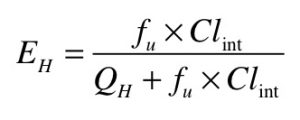Hepatic extraction ratio
The hepatic extraction ratio (EH) refers to the proportion of drug removed by the liver (usually due to metabolism) on a single pass of that drug through the liver. The hepatic extraction ratio lies between 0 (no drug removed) and 1 (all drug removed). The better a drug is as a substrate for one or more hepatic enzymes, the higher the extraction ratio will be. The equation defining the value for hepatic extraction ratio is shown below. The fu term refers to the fraction of drug not bound by plasma proteins, since bound drug can not be metabolised (though it can dissociate from plasma proteins and then undergo metabolism).

Both Clint (the intrinsic clearance) and hepatic bloodflow (QH) have units of litres/hour, and so EH is simply a unitless ratio. From a purely mathematical perspective, it is clear that in order for EH to approach 1, Clint must be at least several times higher than QH (which is around 90 litres/hour) (see the entry for high hepatic extraction ratio drug). If Clint is similar to 90 litres/hour then EH would be around 0.5 (50% of drug removed by the liver in a single pass), while if Clint is several-fold smaller than 90 litres/hour then EH would be very small (see the entry for low hepatic extraction ratio drug).
Click here to watch a short demonstration of how the hepatic extraction ratio impacts oral bioavailability and hepatic clearance.

